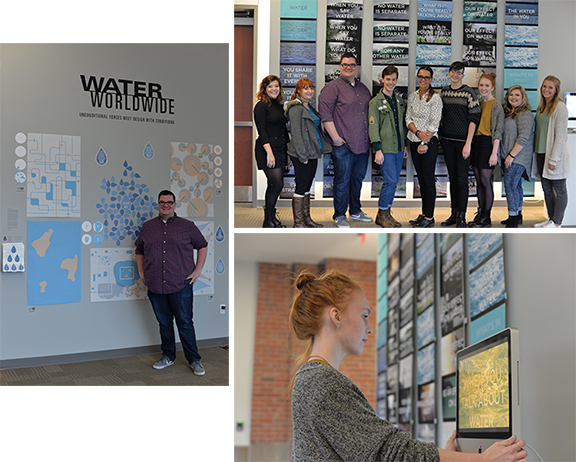
The Advanced Graphic Design and Typography II classes from the graphic design program in the Department of Art and Art History presented "Impetus--an exhibition of visual communications about Water, Food, Fuel and a changing environment" at Nebraska Innovation Campus this summer. The exhibit concluded with a closing reception on Sept. 14.
The exhibition ran concurrently with the University of Nebraska–Lincoln's Water for Food Institute's Global Conference.
The projects, exercises, assignments, and activities established conditions to raise questions, thoroughly examine and then visualize intersections of food, fuel or water and their relationship to a changing climate.
Advanced Graphic design students designed postage stamp systems, promotional posters, campaigns, videos, and interactive installations. Typography II students published a book of Grimm’s Fairy Tales, adapted to visualize these familiar narratives in contemporary times. The work primarily speaks about a future with a greater population, fewer natural resources and the impact we have on our environment.
“My project was about water and our effect on water and our part in the water system,” said Anna Drehs, a senior art major from Lincoln. “I think that it’s important to be able to communicate visually and not just through words. With graphic design, you’re able to show your ideas in a different way.”
Kevin Buglewicz, a senior art major from Papillion, Nebraska, said his project was an extension of an investigation his class did on philately (a study of postage stamps).
“It’s breaking down different ecologies of water use in the world and water inequalities,” he said. “So from flooding to drought to agricultural use of water, there’s different glimpses into the symbolism behind those ecologies, and they all utilize conditional design, which is a method of design which takes the artist out and lets people interact and do the work and following the rules of the conditions.”
Assistant Professor of Graphic Design Stacy Asher said it was a good experience for the students to show their work in a different space.
“They got to experience what is was like to put up work in a public environment or place that is beyond the crit space of the classroom,” she said. “To be able to have that experience and make them realize what it takes to install something in the public long-term was beneficial.”
The research that was involved in creating the work was extensive.
“I think the themes of water, food and fuel align perfectly with what is going on here at Innovation Campus, so it gave them a chance to connect to those subject matters in their own personal way and communicate it,” she said.
Design can help communicate that research.
“It gives form to the content. It gives visual presence and communications to ideas, research and data,” Asher said. “All the scientific things being discovered here have to be presented in some way through data visualization, so art can visualize scientific phenomenon.”
Buglewicz said the students appreciated being able to show their work at Innovation Campus this summer.
“It was really cool. It was one of the first uses of the space ever, which was obviously a really interesting experience,” he said. “Also, just the act of coming and installing the work in a fresh, clean space where people were actually going to see it was rewarding, as a student. The conference was huge, so people got to see it and interact with it.”
It’s an exciting time for the graphic design program at the University of Nebraska. The Department of Art and Art History was just recently renamed the School of Art, Art History & Design. And the School recently announced new majors in graphic design that will begin in the Fall of 2017. Bachelor of Arts and Bachelor of Fine Arts degrees in graphic design will be offered.
“Visual communications and graphic design are often components of social design,” Asher said. “They make knowledge and information visible, tangible and shareable. The graphic design program at UNL trains students to use art and design in particular, social design, to stimulate conversation and focus attention on the environment, history, and civic engagement—with goals of raising awareness to social concerns, encouraging public participation, establishing connections and building community.”
Asher hopes to organize another exhibition at Innovation Campus in the spring, and hopes to include more areas within the School of Art, Art History & Design.
“A lot of our students are interested in exhibition design and installation design and experiential design, so expanding on that would be interesting,” she said. “It’s a great space. It also gives people here something else to look at, both the people who work here and those who attend conferences here. It reaches a broader audience and gives visibility to our program.”